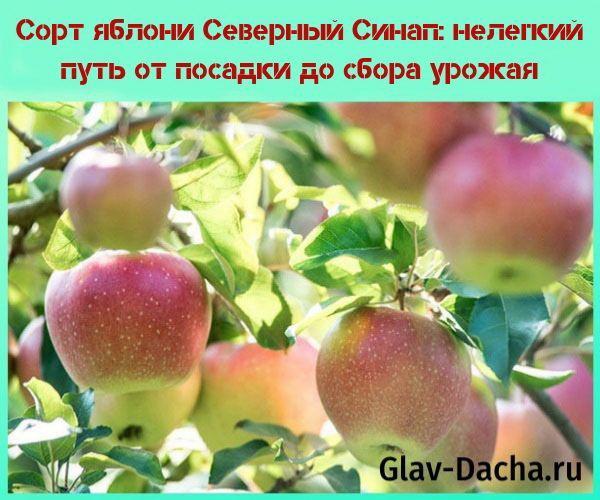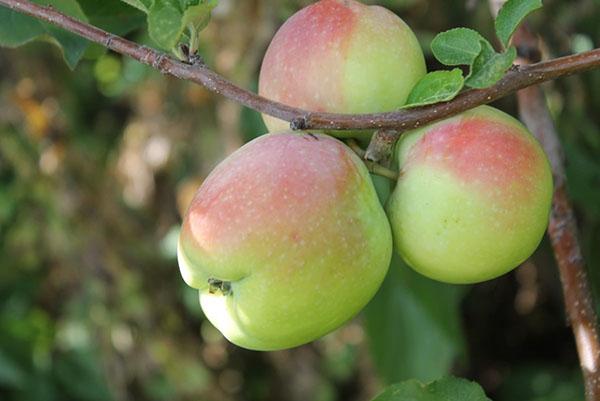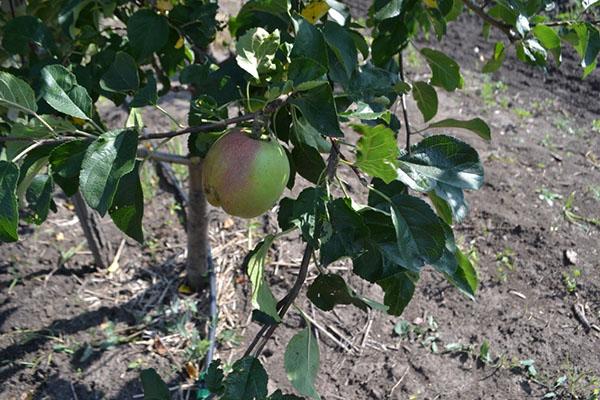The North Sinap apple variety: the hard way from planting to harvest
 Winter hardy, fast growing and high yielding. These are the unique characteristics of the North Sinap apple variety. It is grown in the moderately cold regions of the Northern Hemisphere, as well as in the eastern regions of Siberia. The fruits of the culture are distinguished by a special keeping quality. They have an elongated barrel-shaped shape, and weigh 90-150 g. Their greenish-yellow color gradually acquires a lilac blush as it ripens.
Winter hardy, fast growing and high yielding. These are the unique characteristics of the North Sinap apple variety. It is grown in the moderately cold regions of the Northern Hemisphere, as well as in the eastern regions of Siberia. The fruits of the culture are distinguished by a special keeping quality. They have an elongated barrel-shaped shape, and weigh 90-150 g. Their greenish-yellow color gradually acquires a lilac blush as it ripens.
In addition, the North Sinap apple variety surprises its fans with its wonderful dessert taste, which combines:
- pleasant sweetness;
- unique sourness;
- a kind of spice.

How to find out and choose the North Sinap apple variety among thousands of others
 There are a huge number of seedlings on sale. Some vendors sell common tree varieties for cultivated ones. In order not to be mistaken with the choice, it is important to consider a detailed description of the North Sinap apple tree.
There are a huge number of seedlings on sale. Some vendors sell common tree varieties for cultivated ones. In order not to be mistaken with the choice, it is important to consider a detailed description of the North Sinap apple tree.
To do this, it is worth finding out how the individual parts of the plant look:
- Bark. The branches and trunk are distinguished by an unusual gray (silvery) shade.
- Shoots. Slightly geniculate shoots are brownish and slightly pubescent. Small lentils are very rarely planted on them.
- Leaves. The oblong leaves are presented in the form of small boats, the edges of which are originally raised. The dark green foliage is fairly pubescent, which gives it a grayish overflow.
- Flowers. Large buds have a slight red tint. After blooming, their petals turn pink.
Fruiting of the North Sinap apple tree is expected 5-8 years after planting. Dwarf rootstocks are harvested for 2-3 years.
 The wide pyramidal crown of an adult apple tree is not very dense. The fruits ripen on it in early October. Throughout the entire storage period (60-90 days), the fruits reach full maturity, acquiring a special juiciness and a unique dessert taste. According to statistics, up to 170 kg of fruits are harvested from 1 tree (age from 15 years). To enjoy all the benefits of this variety, you need to know the peculiarities of planting and caring for the North Sinap apple tree. Then the gardener will not have to worry about his harvest.
The wide pyramidal crown of an adult apple tree is not very dense. The fruits ripen on it in early October. Throughout the entire storage period (60-90 days), the fruits reach full maturity, acquiring a special juiciness and a unique dessert taste. According to statistics, up to 170 kg of fruits are harvested from 1 tree (age from 15 years). To enjoy all the benefits of this variety, you need to know the peculiarities of planting and caring for the North Sinap apple tree. Then the gardener will not have to worry about his harvest.
Planting the North Sinap apple tree for gardeners
 Saplings are planted in spacious areas of the garden, where there is a lot of light and heat. At the same time, it is important to maintain a distance to neighboring trees, which should not be less than 7 m.
Saplings are planted in spacious areas of the garden, where there is a lot of light and heat. At the same time, it is important to maintain a distance to neighboring trees, which should not be less than 7 m.
Soil requirements are universal:
- acidity - up to 6 pH;
- occurrence of groundwater - not less than 2 m;
- soil - sandy loam or loam.
The planting of the North Sinap apple variety is planned for March-April or September-October. The planting hole is prepared in a month. Both the width and the depth of the pit should be up to 90 cm. The infertile soil is completely removed from it, and the bottom is dug up. Then a drainage layer (gravel or broken brick) is settled into it. To the fertile soil add:
- rotted manure (2 buckets);
- compost (1 bucket);
- wood ash (0.5 kg);
- superphosphate (100 g);
- potassium sulfate (50 g).
When preparing a seedling for planting, damaged roots / shoots are removed using a sterile pruner. The rhizome is soaked in warm water for 6-12 hours.
The third part of the hole is filled with the resulting soil mixture. A peg is fixed in the center of the pit, which should be 90 cm above the ground level and located on the north side of the plant. A seedling is installed on the formed mound, carefully spreading its roots. The well is then filled with the remaining substrate. In this case, the root collar is not buried (5-7 cm from the ground). After compaction of the soil, the tree is watered with 30 liters of water. The near-bore circle fall asleep mulch: a mixture of peat and humus.
For better growth of the seedling, its shoots are shortened by a third. This stimulates its development and successful engraftment.
North Sinup apple tree care is a gardener's best investment
 Water the planted tree once a week, using up to 30 liters of water. If the summer is dry, then the amount of liquid is significantly increased so that the earth does not dry out. After water procedures, the soil is thoroughly loosened, removing weeds. To stimulate growth and fruiting, the seedling is pruned regularly.
Water the planted tree once a week, using up to 30 liters of water. If the summer is dry, then the amount of liquid is significantly increased so that the earth does not dry out. After water procedures, the soil is thoroughly loosened, removing weeds. To stimulate growth and fruiting, the seedling is pruned regularly.
The event is held in the spring, using the usual scheme:
- the shoots of a young plant are shortened by 40 cm;
- 2-year-old specimens are formed so that they have 3 tiers of healthy branches;
- mature trees are pruned every year, reducing their growth by 20 cm.
The next year after planting the seedling, its near-stem circle is dug up together with rotted manure (600 g / 1 tree). Then, when the buds have formed, they are introduced into the soil urea... Fertilizer granules (450 g) are simply dug into the ground.
Since the flowering process takes a lot of energy from the apple tree, gardeners fertilize the plant with a solution consisting of:
- superphosphate (about 150 g);
- potassium chloride (up to 80 g);
- urea (100 g).
This amount of minerals is diluted in 10 liters of water. You can replace them with bird droppings (600 g) mullein (1 liter of infusion). Superphosphate (60 g) is also added to these ingredients.
The apple tree is also fed after harvest. 70 g of superphosphate are dissolved in 10 l of liquid.
Such a simple technology for growing the North Sinap apple variety has been practiced by gardeners for a long time. A little patience and work will give great results.